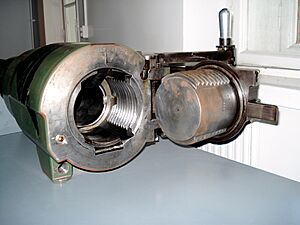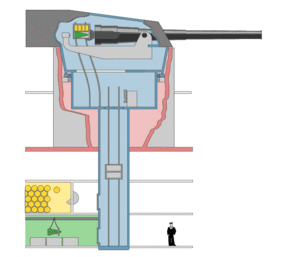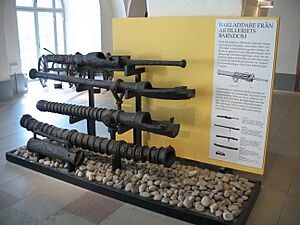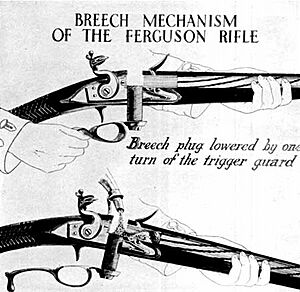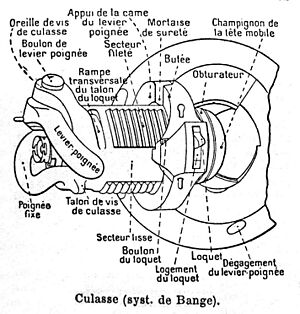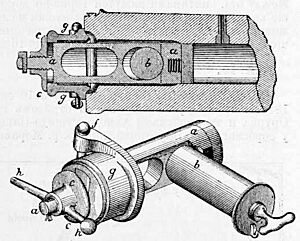Breechloader facts for kids
A breechloader is a type of firearm where you load the ammunition from the back end of the barrel. Think of it like loading a pen from the back! This is different from a muzzleloader, where you have to push the ammunition all the way down the front (muzzle) of the barrel.
Most modern guns today are breechloaders. Before the mid-1800s, most guns were muzzleloaders. Only a few special weapons, like some mortars or rocket launchers, are still loaded from the front. When people talk about a "breechloader," they usually mean guns that fire one shot at a time, like some single-shot rifles or double-barreled shotguns.
Loading a gun from the back (the breech) is much faster! You don't have to reach all the way to the front of a long barrel to push the bullet and gunpowder inside. This is especially helpful for rifles, which have spiral grooves inside the barrel that make the bullet fit tightly. For large cannons, crews no longer had to stand in front of the huge gun to load it. This made cannons much more powerful, accurate, and able to shoot farther. It also made it easier to load a gun that had already been fired and might have some dirt inside.
Breechloaders also allow for smaller gun turrets and spaces, because the crew doesn't need a lot of room in front of the gun to load it. Unloading a breechloader is also much simpler, as the ammunition can often be taken out by hand from the back.
After breech-loading became common, engineers also added special systems to guns to stop them from rolling backward when fired. This meant guns could shoot much faster without needing to be re-aimed every time. It also led to adding armored shields to guns to protect the crew from enemy fire.
Contents
History of Breechloaders
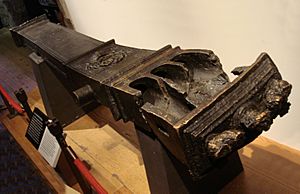
People started experimenting with breech-loading guns as early as the 1300s in Europe. However, they really became successful in the 1800s, thanks to better ways of making things with machines.
The biggest challenge for early breechloaders was sealing the back of the gun so that hot gases wouldn't leak out when fired. This problem was solved for smaller guns by inventing the self-contained cartridge (a single unit with the bullet, gunpowder, and primer). For very large guns, a special "interrupted screw" design helped seal the breech.
Early Swivel Guns
Breech-loading swivel guns were invented in the 1300s. These were small cannons that could turn easily. They were loaded by putting in a cup-shaped chamber that was already filled with gunpowder and projectiles. These guns could fire very quickly and were good at stopping groups of enemies.
Breech-loading Firearms


Breech-loading guns have been around since the 1500s. Even Henry VIII of England had one, which he used for hunting birds! In China, a type of breech-loading musket was made in the late 1500s. However, a big problem with all these early designs was that gas would leak out when the gun fired, which was dangerous.
More breech-loading firearms appeared in the early 1700s. For example, a gun made around 1715 for Philip V of Spain used a reusable cartridge that was ready to load.
In 1772, a British officer named Patrick Ferguson created the Ferguson rifle. About 200 of these rifles were used during the American Revolutionary War. Later, the American army adopted the M1819 Hall rifle, which was another important early breechloader.
Around this time, people in Europe were also trying to make better breechloaders and improve cartridges.
- In 1808, Jean Samuel Pauly in Paris created the first truly self-contained cartridges. These cartridges had a copper base with a special primer powder, a bullet, and a casing made of brass or paper. The gun was loaded from the back and fired with a needle. This "needle-activated" system was a major step forward for firearms.
- Casimir Lefaucheux improved Pauly's cartridge in 1828 by adding a "pinfire" primer.
- In 1845, Louis-Nicolas Flobert invented the first "rimfire" metallic cartridge for indoor shooting. These small cartridges, like the ones used in .22 BB and .22 CB ammunition, didn't have gunpowder; the only propellant was in the percussion cap itself.
- In 1846, Benjamin Houllier patented the first fully metallic cartridge that contained gunpowder inside a metal shell.
- The first "centrefire" cartridge, which has the primer in the center of the cartridge base, appeared in 1855.
In 1842, the Norwegian Armed Forces adopted the Kammerlader, a breech-loading rifle. This was one of the first times a modern army widely used a breech-loading rifle as its main infantry weapon.
The Dreyse Zündnadelgewehr, or Dreyse needle gun, was a single-shot breech-loading rifle developed in the 1830s and adopted by Prussia in the late 1840s. It was called a "needle gun" because its firing pin was like a long needle that went through a paper cartridge to hit the primer at the bullet's base. Even though it had problems with gas leaks, the Prussian army used it very successfully in wars in 1866 and 1870-71. This made other countries very interested in breechloaders.
During the American Civil War, many different types of breechloaders were used. The Sharps rifle had a successful "dropping block" design. The Spencer repeating rifle could hold seven rounds in a tube magazine. The Henry rifle and Volcanic rifle used rimfire metallic cartridges from a tube magazine under the barrel. These guns were much better than muzzleloaders. To use the many muzzleloaders left over after the war, some were changed into breechloaders.
In 1866, the French army adopted the Chassepot rifle, which was a big improvement over the Dreyse needle gun because it had far fewer gas leaks. The British also updated their existing rifles to use a breech-loading system.
Single-shot breechloaders were common in the late 1800s, but they were slowly replaced by repeating rifles that could fire multiple shots without reloading. Eventually, manual breechloaders led to self-loading rifles.
Today, breech-loading is still very common in shotguns and hunting rifles.
Artillery
The first modern breech-loading cannon with a rifled barrel was invented by Martin von Wahrendorff in 1837. In the 1850s and 1860s, inventors like Whitworth and Armstrong also created improved breech-loading artillery.
How a Breech Mechanism Works
A breech mechanism is the part of a breech-loading gun that opens and closes to allow loading and firing. Early breechloaders might have had barrels that tipped down or plugs that were removed. The Ferguson rifle used a screw-in system to load. The Hall rifle tipped up to load.
Better breechloaders, like the Sharps rifle, used a "falling block" system that slid down to open the breech. The Dreyse needle gun used a moving "bolt" to seal and open the breech. Later, rifles like the Mauser M71/84 used self-contained metallic cartridges and a rotating bolt to open and close the breech.
See also
- Breechblock
- Interrupted screw
- Rifled musket
- Rifled breechloader


